-
Car Reviews
- All reviews
- Midsize SUVs
- Small cars
- Utes
- Small SUVs
- Large SUVs
- Large cars
- Sports SUVs
- Sports cars
- Vans
Latest reviews
- Car News
-
Car Comparisons
Latest comparisons
- Chasing Deals
The first new-generation Toyota LandCruiser Prado in 15 years arrives with the weight of expectation heavy on its retro-styled shoulders.
It’s here. The first new generation Toyota LandCruiser Prado for 15 years, with retro boxy design, more capability, plusher cabin, better tech and price hikes to suit.
And good grief, we Aussies aren’t shy of an opinion or three about it. Be it at the pub, campfire, office watercooler or on social media, the new Prado 250 Series – starting from $72,500 plus on-roads – is the hot topic for discussion and critique.

Along with the love, there are questions. Does it look like a plus-size Suzuki Jimny? Why’s the boot design weird? No spilt tailgate? No rear diff lock? It needs AdBlue?
Why’s the diesel engine not had a power hike? Why’s the fuel tank so small? Where’s the petrol version? What’s with the GVM and decreased payload? Can’t I get round headlights? It costs how much?
Yep… endless. But Toyota knows it’s got a desirable product here. Australia’s the globe’s largest ‘LandCruiser family’ market for good reason, and over 17,000 new Prado 250s have been pre-ordered before even hitting showrooms. With an estimated 27,000 arriving in the first 12 months, it’s already a guaranteed sales smash. They’ve clearly done plenty right.

Now, finally, we’ve driven it. Across three days in Darwin and Kakadu National Park, we endured 40C+ temperatures with a high humidity chaser, rain showers rapidly turning hard-baked tracks into slippery red mud, volcanic rock hill climbs, deep river crossings and, for contrast, suburban roundabouts.
Feral water buffalo, dingoes, crocs and Darwin locals all added to the colour.
Next to the old Prado, the drive and cabin refinement have surged ahead. Built on the TNGA-F ladder-frame chassis shared with big brother LandCruiser 300 Series, the idea was to match the 300’s rough road ability while retaining the more on-road friendly nature that makes Prados so appealing to Aussie families.

Navigating Darwin’s ‘burbs, the ride is uncommonly good for a body-on-frame vehicle. No, it can’t compete with a proper monocoque large SUV – it still jitters and bobs along on urban roads with its solid axle rear suspension – but next to a rival like the Ford Everest there’s impressive ride quality.
Road humps and potholes are comfortably dispatched, even without the higher grades’ (VX and Kakadu) adaptive variable suspension, although this comes into its own on rougher roads.
Despite an upright windscreen and large, chunky door mirrors, wind noise is kept well at bay, even as we approach highway speeds. Insulation feels as solid as the cabin’s build quality, while visibility through large glass (helped by low window frames) is excellent.

A 360-degree camera view pops up in the central screen at low speeds, helping navigate tight city streets as much as skinny off-road tracks.
Steering’s a huge step-change. Gone is the old hydraulic setup, replaced by electric power steering for the first time. Around town, the wheel needs effortless inputs as it’s incredibly light and easy. Fear not, it doesn’t feel disconnected, but manoeuvres, turns and slow cornering can be done with fingertips.
Add some speed and the steering firms up, and there’s solid response and feel for such a heavy thing, especially when hurtling along unsealed tracks or twisty back roads. It’s not brimming with feedback, but it’s damn impressive and transformative to a Prado’s drive experience.

Sitting in the smartly updated cabin (more on that shortly) and appreciating the improved drive experience, the engine feels rather left out of the mini revolution. It’s the same 2.8-litre four-cylinder turbo-diesel good for 150kW and 500Nm.
Plenty of Prado watchers have criticised this lack of progress with no bump in power or torque, and questioned why there’s no six-cylinder nor petrol offered. The Lexus GX550 (from $116,000) is basically a posher Prado, and features a 260kW/650Nm 3.5-litre V6 twin-turbo petrol.
In the US, the Prado comes with a 243kW/630Nm 2.4L turbo four-cylinder hybrid – this unit is bound to make an appearance here soon.
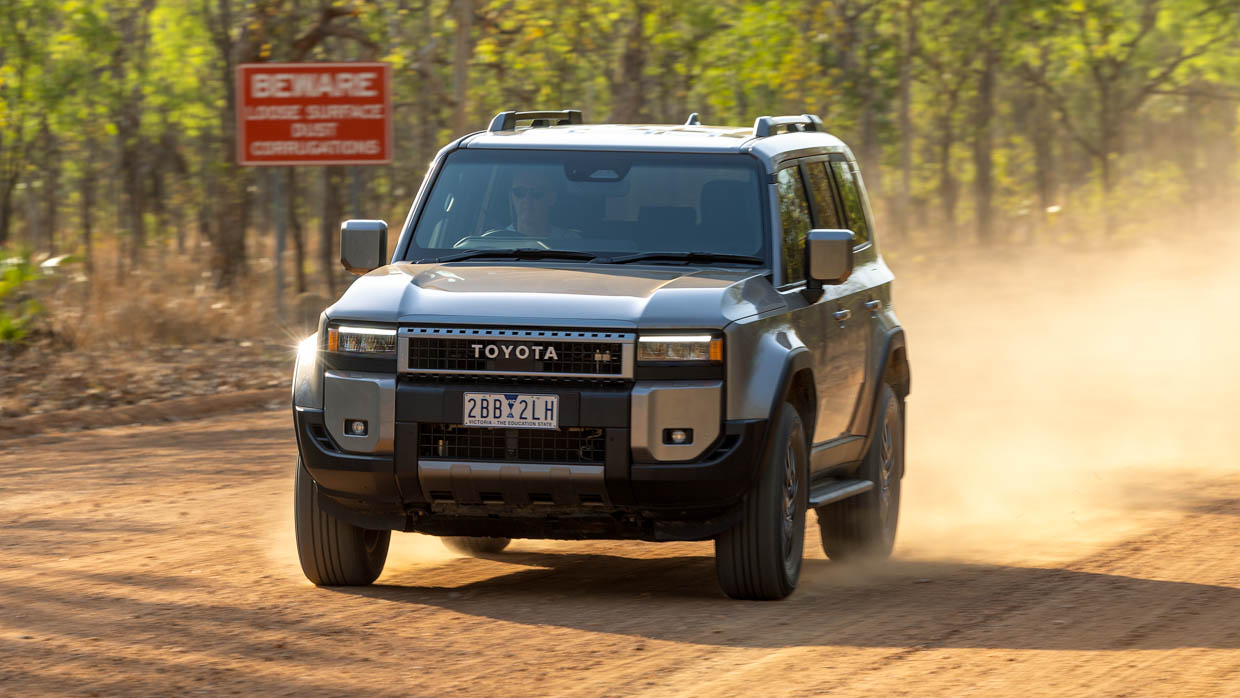
For now, it’s that 2.8L diesel or nothing. It’s familiar, long-tested and reliable, and only when seriously pushed does it feel agricultural and rattly. Owners use their Prados in so many ways – it’s a consummate all-rounder – so some will understandably grumble about a lack of guts.
But after three days of town, highway (it’s 130km/h limited in the NT) and off-roading, lack of shove never proved an issue. Even so, as the rest of the car feels quite revolutionary, a more modern-feeling powertrain feels like a missed opportunity.
It’s a mild hybrid like the new Hilux, but not to be confused with a ‘proper’ Toyota hybrid which can run on battery power alone. Here, there’s 48-volt assistance to slightly improve fuel economy, but also help smoothness and responsiveness.

It’s absolutely noticed, helped by Toyota slinging in a new eight-speed auto to replace the old six-speed ‘box. The system offers short bursts of acceleration assistance to fill in torque gaps, and we’re told shift response is 25 per cent improved over the old Prado.
No paddle shifters is a shame, but really, the transmission is such a slick operator you’re happy to let it work everything out for you.
Economy? We managed 7.9L/100km on the highway, and then 10.3L/100km when throwing in a few hours of off-roading. Solid if not spectacular numbers.

Now a permanent 4×4 with high-/low-range transfer case, the new Prado’s larger than before – up 165mm to 4990mm long and wider by 95mm to 1980mm. The wheelbase is stretched by 60mm to 2850mm, and front and rear tracks are widened by 79mm and 83mm respectively.
Regardless, it hides its size well. It feels nothing like as cumbersome in town next to a LandCruiser 300, and while there’s expected body lean in corners, the Prado has praiseworthy poise for such a big rig.
Importantly, it feels safe and composed at speed, coping with greasy roads and direction changes despite a kerb weight starting at 2500kg.
How it performs as a daily driver is imperative. For many Aussie families, a Prado’s the urban runabout and school drop-off bus before being an off-road adventurer, with the latter ability rarely explored. Well, save the odd trip up the beach or camp site unsealed road.


Pictured above: the Prado GX
Such users will care more for cabin comfort and specification ahead of any talk of rear diff locks. To that end, you must carefully explore the offerings in each of the five Prado grades and weigh them up against prices.
Here’s the walk-through. Entry level’s the $72,500 GX. No small amount of money, but you’re faced with just five seats coated in fabric (they’re damn comfy, actually), a rather cheap feeling urethane steering wheel, rubber floor mats, analogue driver display with 7.0-inch digital section, and you must open the tailgate yourself.
The glass rear screen handily pops open at the touch of a button, but there’s no split tailgate nor spare wheel on the back – it’s now under the vehicle beneath the boot.

Combined with the 48v hybrid gubbins, the fuel tank is limited to just 110L, and we’re told there’s no current plans for a larger or supplementary one, as it’d require complex engineering.
What we do now have – and this has made many grumpy – is a 17.4-litre AdBlue tank. This fluid is injected into the exhaust system to reduce nitrous oxide emissions, and will likely need to be refilled (annoyingly) between services, depending on use.
It’ll typically last about 8500km, but service intervals are every six-months/10,000km, so you’ll have to refill it yourself, but we’re promised there’s plenty of warning. If it runs dry, the car simply won’t start.

Services, by the way, are $390 per visit. Across five years (ten services) that’s $3900. Compare that to a Toyota Kluger’s $1250 for five years (five services) and it’s tough on the family budget.
The entry-level Prado GX still presents well inside. Soft plastics are found up high and only scratchier ones found lower, and there’s decent padding at knee level and on armrests for long-distance touring.
All feels solid and smartly laid out, with switches and buttons having a robust feel. No daft controls through the screen, so climate is easy to sort out even when bounding along off-road. Special mention to seriously effective air conditioning.


Pictured above: the Prado GXL
All Prados score a 12.3-inch infotainment touchscreen, run embedded and cloud-based sat nav, have wireless Apple CarPlay and Android Auto, five USB-C ports, HDMI port and handy 220V power outlet in the boot.
But families should want to move up to the $79,990 GXL grade, not least for the third row of seats it brings.
The extra $7500 appears worth it as there’s also synthetic leather upholstery, power driver’s seat, heated and ventilated front chairs, leather-accented steering wheel, wireless smartphone charging, two more USB-C ports and a power tailgate. This grade will likely make up half of all Prado sales.


Pictured above: the Prado VX
For $87,400 the mid-spec VX drops 18-inch wheels for 20-inchers, a LUX front grille replaces the more retro milk crate grille, while it looks more street-suave with body-coloured front and rear bumpers and fender mouldings.
Mechanically, it gains five-mode Drive Mode Select, multi-terrain select and adaptive variable suspension, backed by a superb multi-terrain monitor using extra cameras.
Cashed up tourers should favour this VX. There’s a marked rise in quality feel to the now leather-accented upholstery, there’s power lumbar support and memory driver seat, a 12.3-inch digital instrument cluster arrives, as do front and rear carpet floor mats.


Pictured: the Prado Kakadu
There’s a handy (but not large) refrigerated centre console box, JBL audio and tyre pressure warning too; the latter, really, should be on all Prados.
Priciest of all is the $99,990 flagship Kakadu. You get a panoramic moon roof, illuminated side steps, heated and ventilated seats front and rear, heated steering wheel, digital rear-view mirror, adjustable driver’s seat cushion and a head-up display. It also scores a rear Torsen limited-slip differential.


Pictured above: the Prado Altitude
The outlier is a $92,700 Altitude grade with more hard-core off-road focus. Like the lesser grades, its front grille boasts bold TOYOTA lettering, while its 18-inch matte grey alloy wheels have Toyo Open Country all-terrain tyres.
Only this grade comes in striking Ningaloo Blue or Tanami Taupe colours with contrast light grey roof.

Sling on a body-coloured squared-off steel bulbar from the Toyota Genuine Accessories catalogue and it looks the business, especially paired with a Toyota bespoke Warn-sourced 9000-pound (4080kg) winch sitting behind the number plate.
These Altitudes are only five seaters but include the head-up display, heated steering wheel and part-leather trim. The toughest in appearance, they’ll likely be the popular ‘look-at-me’ choice in suburbia. But they really need a round headlight option as seen in American models.
The Altitude’s also the more advanced off-road choice. Like the VX and Kakadu it has 221mm ground clearance (GX/GXL are only 210mm), but is the only Prado to boast a rear electrical diff lock and a stabiliser disconnection mechanism for better off-road articulation.

Moving back inside, rear seats offer strong head and legroom, but drop versatility points by not sliding on runners. The middle rear seat is firmer and not that comfy as the transmission tunnel’s quite intrusive.
For seven-seaters, the middle seats roll forwards simply to allow access. As a six-footer I’d not be keen to travel in seat six or seven for too long, but space is tolerable, there are cup holders and USB-C ports, ventilation’s fine and windows large so you’re not too claustrophobic. They’d be ample for most kids.
There’s a bit of trouble in the boot, however. With seven seats up you’re left with skinny 182L storage, which Toyota’s filled with a cheap-feeling plastic box. It has a weight limit of 60kg, but at least can be easily removed. Regardless, it feels like a strange afterthought.

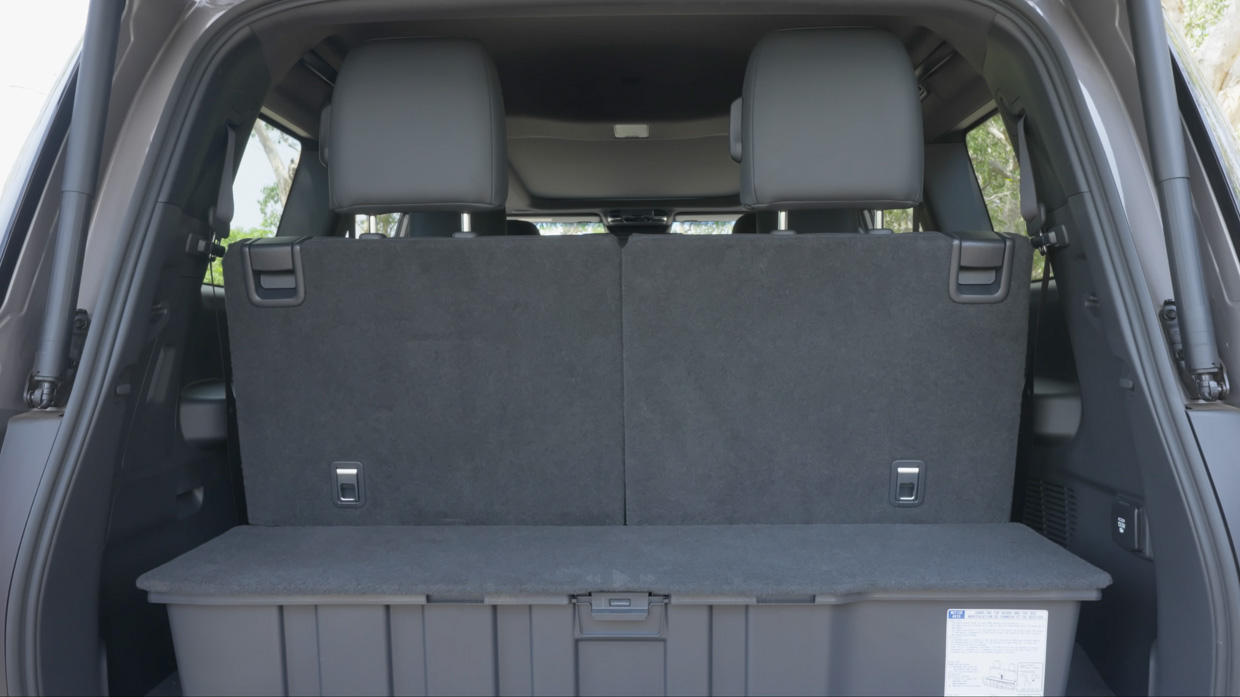
It can be fiddly accessing the plastic handles to raise and lower the seats if you do so through the boot, and the boot shape means there are gaps to the seat sides where your kit (or shopping) will fall into.
It’s exacerbated if you roll forward the middle seats, leaving awkward shapes in which to pack your gear.
The five-seaters have more conventional boot space, with generous 954L to the roof. But even then there’s a raised boot floor with minimal space for valuables beneath, while the seven seat versions’ arm rests and cup holders remain, compromising loading. All rather sub-optimal.

Another grumble to address is the new Prado’s GVM and payload concerns. It’ll now tow 3500kg (up from 3000kg), with Gross Combination Mass 6600kg range-wide. You towing lot will have to do all your weights and measures, but lowest payload is the Altitude’s 580kg with 3100kg GVM.
If towing a 3500kg trailer, deducting a 350kg towball download mass, you’ve only got a 230kg payload to play with.
We didn’t tow test, but managed a solid mix of off-roading.
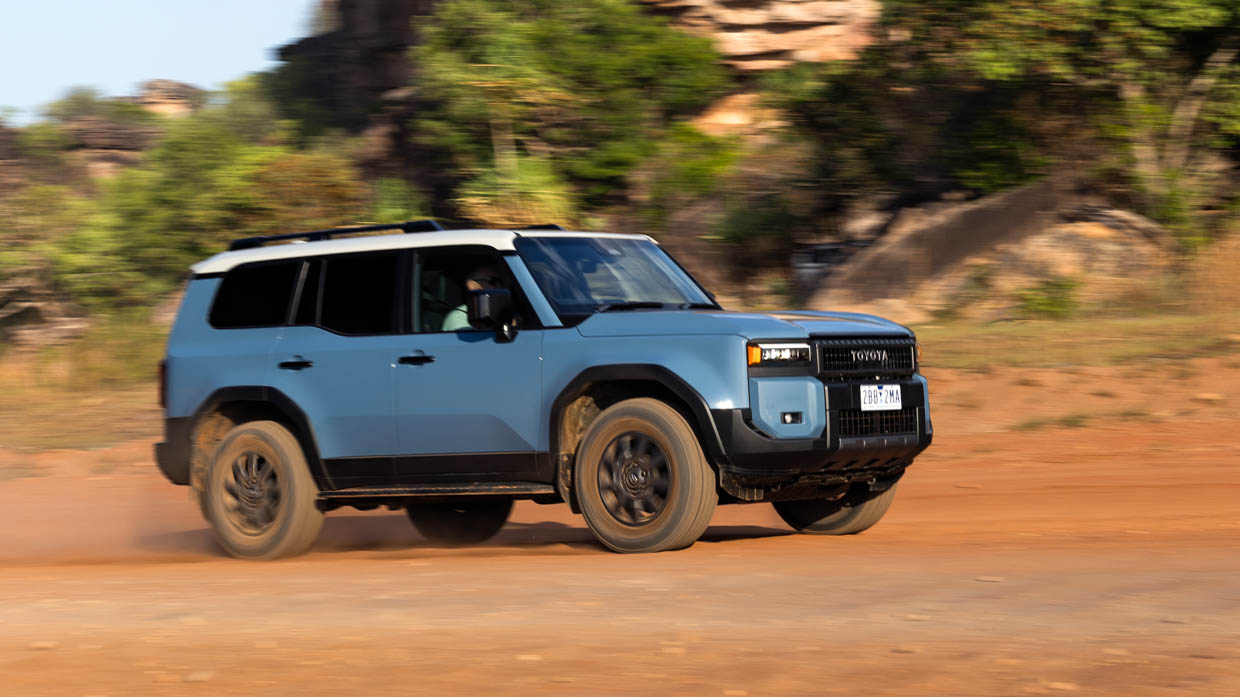
A few hours of highway driving to reach Kakadu had us acquainted with the driver aids, which proved largely non-nannying. All Prados are well furnished here, including really appreciated stuff like adaptive cruise control, advanced auto emergency braking, blind spot monitor and rear cross-traffic alert.
I’m not typically a fan of lane trace assist where the car continually steers you into the centre of the road, but Toyota’s got a good ‘un. On 130km/h NT roads, it’d gently ease the steering wheel as we took long corners, removing much of the driving effort.
With the general smooth ride, noise suppression, comfy seats and steering assist, you remain relaxed and unstressed after a few hours in the saddle.

It’s utterly fit for purpose on the rough stuff. Solid steering feel on open dirt roads gave confidence to keep speeds high; stability and traction control were quiet and non-invasive, and the ABS tested superbly during loose surface emergency stops.
The Prado took some severe hits in big holes, yet the electric power steering means much less steering wheel kick-back. It mops most bangs up with aplomb.
A 50 per cent increase in the frame’s torsional rigidity improves off-road ride and handling, and greater suspension travel over old – equalling previous Prados fitted with Toyota’s KDSS – brings superb sure-footedness. I swear we didn’t once bash the underside over our testing course.

The move into low range is a clunk-free ease, but turning off all the sensors for tight off-road paths is more of a faff. A simple solid button by the steering wheel would be preferable to diving through screen menus.
The GX and GXL may have open front and rear diffs, but their centre diff lock offered extra traction through the more testing sloppy mud and river crossings.
The ability and comfort proved ample for Kakadu’s often tricky terrain, helped by smart stability and traction control. You hardcore lot will doubtless gravitate towards the Altitude, or – as many do – get busy with aftermarket enhancements.

Reporting on our journey, trickier off-road sections were helped by the Drive Mode select, but didn’t prove a deal-breaker.
The 360-degree camera showing the vehicle’s sides and front end are a superb aid when pointing skywards or along skinny paths, while all but the GX and GXL get a multi-terrain monitor, showing the underside view too. Superb to avoid large rocks or tree stumps.
I must caveat this review by recognising the new Prado 250 Series was launched in absolutely the correct place to make it shine. That’s no slur – many will end up in remote, challenging spots like Kakadu, and I’ve no doubt it’ll excel.
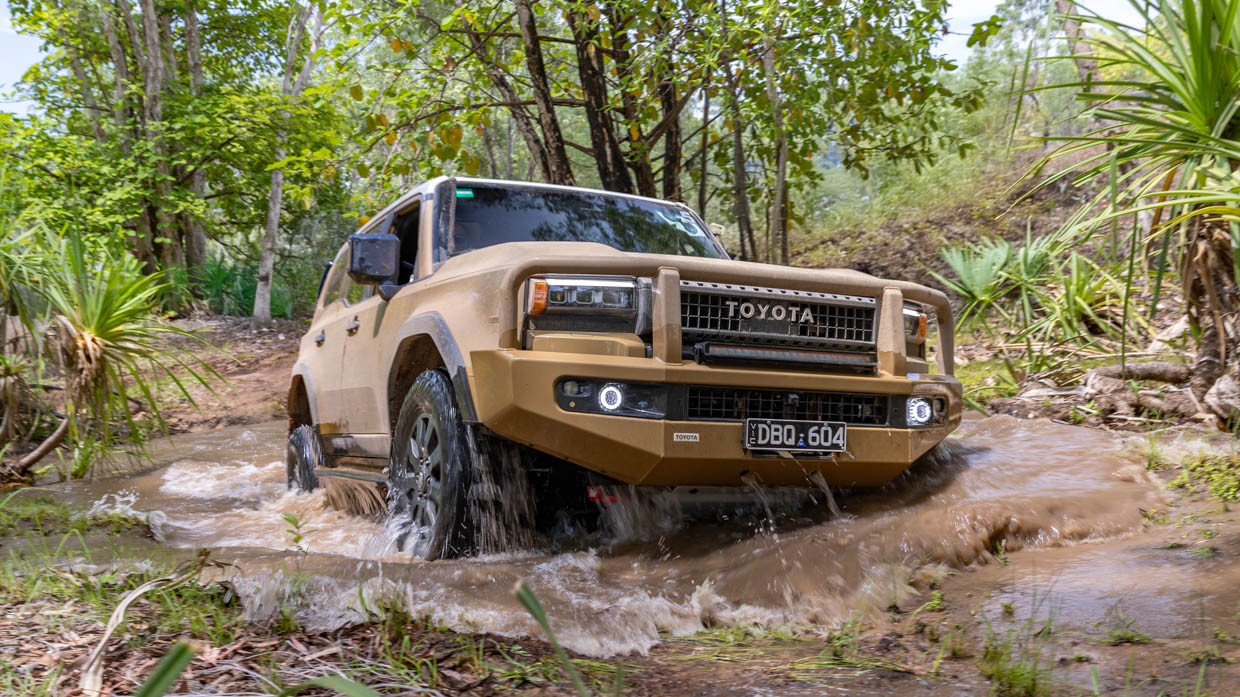
After three days of driving, a Land Rover Defender aside, I can’t think of a more competent, comfy 4×4 to tackle the large family school run, an off-road safari and then a lap of Australia in quick succession.
And – apologies Land Rover – I’d feel more at ease doing so in something wearing a Toyota badge.
On initial try the new Prado’s not perfect, but positives far outweigh negatives. Its retro looks are tough yet charming, the interior’s a massive upgrade, and there’s ample tech and safety. Key is it’s better off-road and markedly improved on-road, where many will ply their trade.
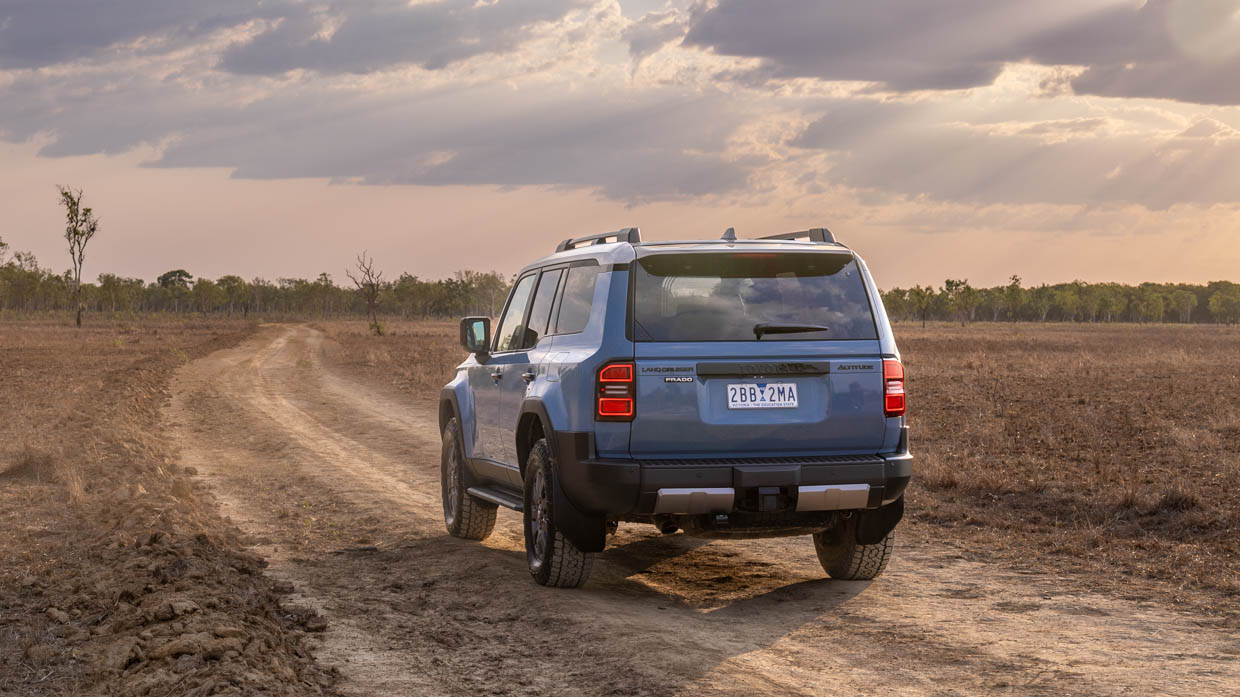
High servicing costs and the weird boot space are challenges, while adventurers, off-roaders and towers must consider the 110L fuel tank, AdBlue requirements, GVM and payload. But for many, the new Prado 250 is utterly fit for purpose and, come on, looks the absolute business
Key specs (as tested)
About Chasing cars
Chasing Cars reviews are 100% independent.
Because we are powered by Budget Direct Insurance, we don’t receive advertising or sales revenue from car manufacturers.
We’re truly independent – giving you Australia’s best car reviews.
The estimate provided does not take into account your personal circumstances but is intended to give a general indication of the cost of insurance, in order to obtain a complete quote, please visit www.budgetdirect.com.au. Estimate includes 15%^ online discount.
^Conditions Apply
Budget Direct Insurance arranged by Auto & General Services Pty Ltd ACN 003 617 909(AGS) AFSL 241 411, for and on behalf of the insurer, Auto & General Insurance Company Limited(ABN 42 111 586 353, AFSL 285 571).Because we don’t know your financial needs, we can’t advise you if this insurance will suit you. You should consider your needs and the Product Disclosure Statement before making a decision to buy insurance. Terms and conditions apply.
Indicative quote based on assumptions including postcode , 40 year old male with no offences, licence suspensions or claims in the last 5 years, a NCD Rating 1 and no younger drivers listed. White car, driven up to 10,000kms a year, unfinanced, with no modifications, factory options and/or non-standard accessories, private use only and garaged at night.
^Online Discounts Terms & Conditions
1. Discounts apply to the premium paid for a new Budget Direct Gold Comprehensive Car Insurance, Third Party Property Only or Third Party Property, Fire & Theft Insurance policy initiated online on or after 29 March 2017. Discounts do not apply to optional Roadside Assistance.
2. Discounts do not apply to any renewal offer of insurance.
3. Discounts only apply to the insurance portion of the premium. Discounts are applied before government charges, taxes, levies and fees, including instalment processing fees (as applicable). The full extent of discounts may therefore be impacted.
4. We reserve the right to change the offer without notice.